06 Feb 2025
TJ Gaushas
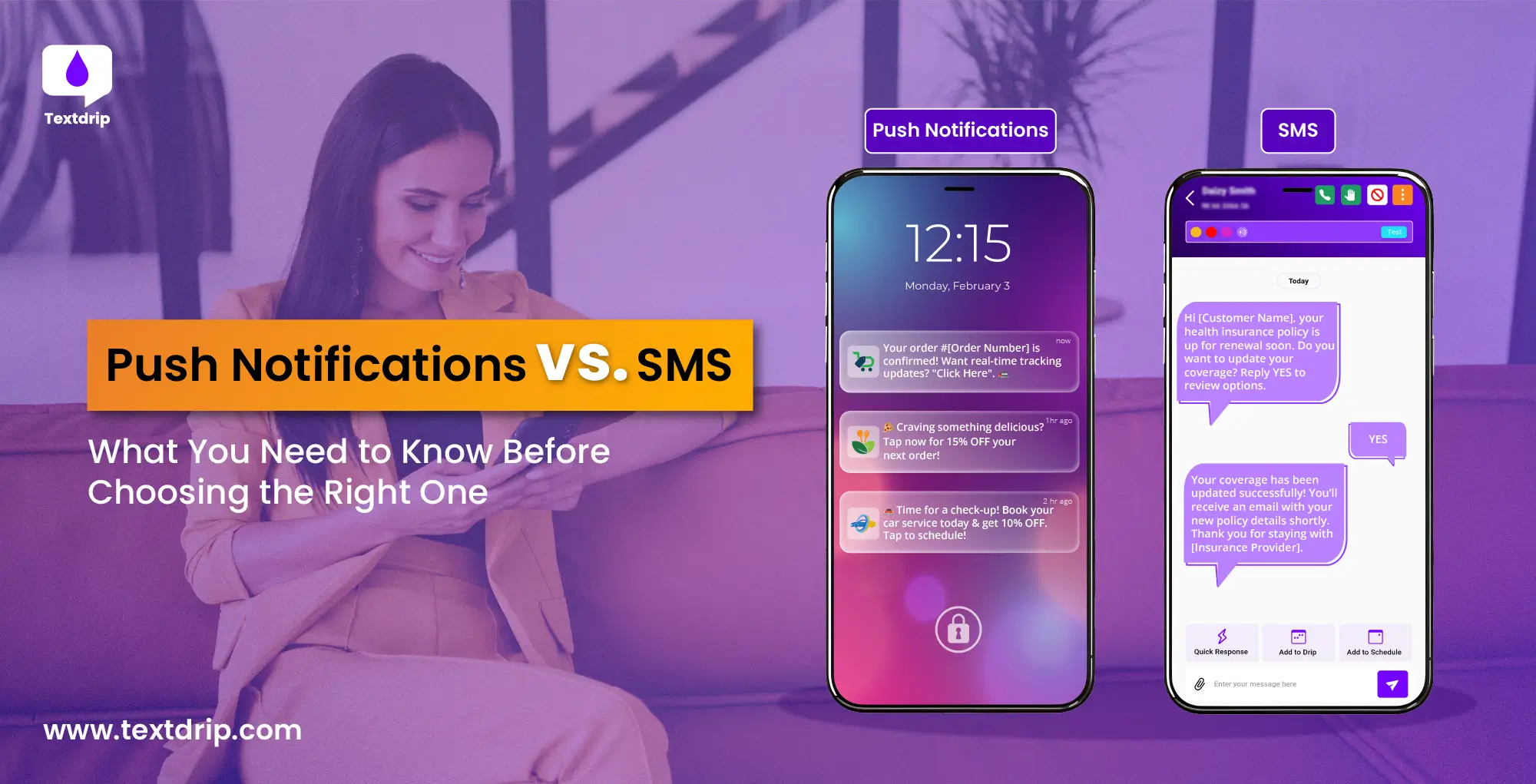
06 Feb 2025
TJ Gaushas
These days, consumers use smartphones for almost everything – banking, shopping, social, food ordering, entertainment, education, and whatnot! According to a study done by Statista, US people spend around 4 hours and 39 minutes on a mobile phone. That’s why businesses must communicate with customers via the communication channels they use most. SMS and push notifications are two such communication channels. However, understanding the difference between push notifications vs. SMS is crucial to selecting the ideal communication channel for your business. This blog explains the difference between SMS & push notifications when to use each, and how to decide which solution is perfect for your business.
So, without further ado, let’s get started.
Push notifications are small clickable pop-up messages that appear on the mobile device. A business sends these messages to consumers via a mobile app or a website. There are three main types of push notifications.
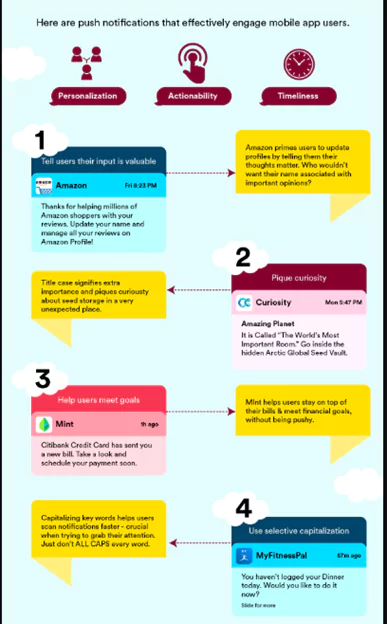
Source: Link
We can further classify them based on their use cases
| Push Notification Type | Description | Use Case |
| Informational | Provide important updates, news, or general information | Weather alerts, traffic updates, breaking news |
| Promotional | The main goal is to promote products, services, or special offers | Discount code, limited-time sales, new product launches |
| Reminder | Help users stay organized by sending reminders about upcoming events | Calendar events, subscription renewal, bill payment |
| Social | Related to social media platforms/apps | Alert users about new messages, likes, comments, mentions, or friend requests |
| Personalized | Customized as per individual user’s preferences, browsing history, or app usage | Recommend users new products to try, places to visit, or new content to explore |
| Transactional | To confirm or update users on their transaction status like online purchase, booking, or delivery | Order confirmation, shipping updates, and payment receipts |
| UGC | Inform users about new content created or shared within a community or platform. | Forum replies, blog posts, or group messages |
| Re-engagement | Encourage users to return to an app/website they have not used in a while | Abandoned shopping cart reminders, showcase new features, or invite them to participate. |
Push notifications appear on the screen as a banner, badge, or alert. Its main goal is to notify users about new content, updates, events, reminders, products/services, or other relevant information.
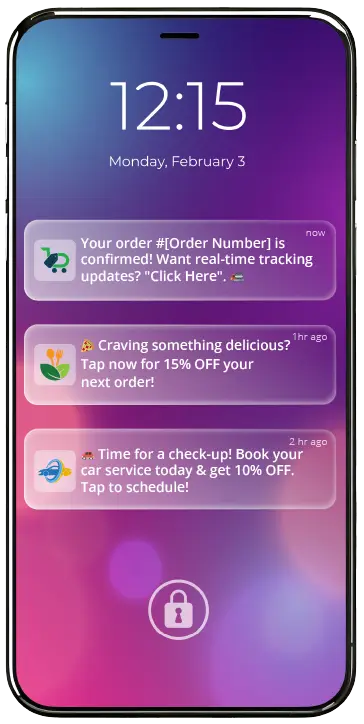
The main benefit of push notifications is that users don’t need to be in a specific app or a website to see them. The key characteristics of these push notifications are as follows.
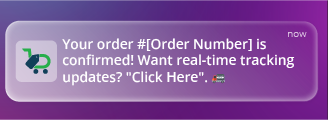
Push notifications are made up of icons, titles, date & time, and message text.
| Icon | Businesses use their logos so that users can easily recognize their brand and increase open rates |
| Title | Around 30 to 40 characters |
| Time and Date | Shows how old the notification is |
| Text message | 120 to 150 characters |
Here are a few advantages that push notifications offer:
In short, push notifications are most effective when you want to engage app users, drive web traffic, and improve user experience.
It is the most common form of communication and is widely used today. It is a type of message that is sent from one mobile device to another. Anyone with a mobile phone will be familiar with SMS, the native text messaging app built into their device.
The SMS character limit is 160 characters and does not include images or videos. For attaching videos/images, businesses need to use MMS. You can learn the difference between SMS vs MMS messaging in our guide.
Although SMS do not include images or videos, they deliver information to users directly, whether it is about promoting products/services or reminding them about appointments.
SMS are widely used for business and personal communications as they are fast and convenient ways to deliver information to individuals or groups without internet connectivity.
There are three main types of SMS communication.
Generally, businesses can use SMS for various purposes such as two-factor authentication, delivery and travel updates, payment notifications, fraud and weather alerts, promoting products or services, customer service, and appointment and medication reminders.
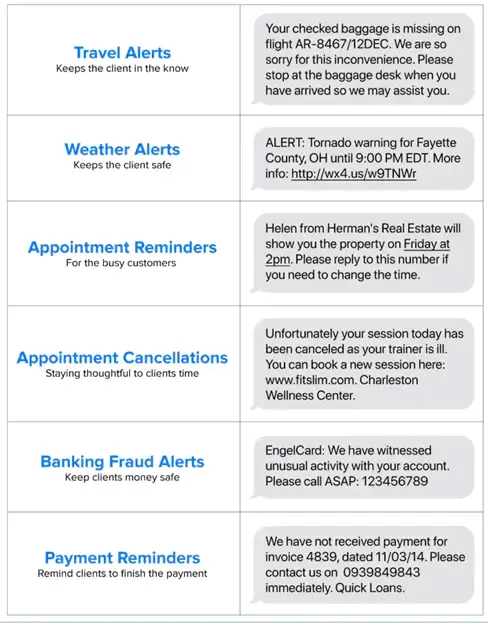
Source: Link

Source: Link
SMS text messages contain the following elements.
| Profile Picture | Sender’s icon is displayed if a picture has been added to the device’s contact list. |
| Phone Number | Includes country code, area code, personal number, short code, long code, or business name (if allowed by carriers) |
| Time, Day, and Date | Shows how old the SMS message is |
| Message Text | 160 characters |
In short, SMS is more effective in reaching a wider audience and sending time-sensitive messages. As it offers high open rates and quick response times, it is a direct, quick, and highly reliable communication channel.
The following table demonstrates the core difference between push notifications and SMS.
| Feature | Push Notification | SMS |
| User consent | Requires opt-in through app or mobile | Require opt-in through phone number |
| Delivery Method | They are app/website based and require internet | They are phone number based and don’t require internet. |
| Delivery Speed | Faster than SMS but affected if the user’s device is not connected to the internet. | Sent through the mobile network. It can be affected by factors such as network traffic. It can delay message delivery. |
| Reach and accessibility | Limited to app users | Works on all mobile devices |
| Message format | Supports images, buttons, and rich media | Text-only (160-character per message) |
| Timing and Frequency | Best for frequent engagement | Best for urgent, time-sensitive messages |
| Personalization | High based on user behavior | Limited as only have an opt-in or opt-out option. |
| Cost | Initial costs involve app development costs. After that, it is free. | It usually incurs a per SMS cost (pay as you go pricing) or a set package cost for bulk text messaging for sending a certain number of messages. |
| Communication | One-way | Two-way |
Here are a few factors that you need to consider while deciding whether to choose push notification or SMS for your business.
Choose SMS if your users are offline, non-smartphone users, or in areas with limited internet connectivity. SMS is the right choice for reaching a broader audience. Push notifications are the perfect fit if your audience base is online and users frequently engage with your app.
If you want to send rich media content, push notifications are ideal. SMS works perfectly for concise and text-based alerts.
OTPs, time-sensitive messages, and emergency alerts should go through SMS. You can choose push notifications for promotional updates.
Push notifications are excellent if your main goal is to engage app users. However, if you need a guaranteed way to reach customers, SMS is perfect.
Instead of choosing one over the other, combine both and implement a comprehensive combined multichannel communication strategy. For example, use push notifications for engagement purposes such as promotions, updates, or personalized content. If you want to send important alerts such as OTPs, order confirmations, or reminders, use SMS. You can even follow up with an SMS if a push notification is not delivered.
In a nutshell, deciding between push notifications or SMS is dependent on your business needs and customer’s preferences. Each communication channel has its own advantages and disadvantages. You might find that some users pay more attention to push notifications, whereas others might be more interested in receiving SMS. So, depending on how your customers respond to either communication, you need to customize your marketing campaigns.
The best way is to combine both and strike the right balance of multichannel marketing techniques to increase conversion, engagement, and retention rates. Now that you know the difference between push notifications vs. SMS, understand your target audience and the nature of your business, and choose the one that perfectly aligns with your business goals.
To help you get started, at Textdrip – the best SMS marketing platform, you can book a demo to find out whether SMS marketing is a perfect fit for your business.
Push notifications are great for engaging users already using your app, while SMS is better for reaching a wider audience, including those who haven’t downloaded your app.
Yes, users can disable push notifications through app settings, and they can opt out of SMS by replying with keywords like “STOP,” depending on compliance requirements.
No, push notifications are primarily one-way. SMS allows two-way communication, making it ideal for customer support and engagement.